Hallo,
ich unterstelle im folgenden, dass die Seite \(a=AB\) parallel zur Seite \(c=CD\) verläuft.
Stelle zunächst die Geradengleichung \(a\) auf, die durch den Punkt \(A\) und in Richtung des Vektors \(\vec{DC}\) verläuft$$\begin{aligned}a: \quad \vec x &= A + t(C-D) \\&= \begin{pmatrix}-2\\ 8\\ -3\end{pmatrix} + t \left( \begin{pmatrix}-3\\ 3\\ 5\end{pmatrix}- \begin{pmatrix}-5\\ 6\\ -1\end{pmatrix}\right) \\&= \begin{pmatrix}-2\\ 8\\ -3\end{pmatrix} + t \begin{pmatrix}2\\ -3\\ 6\end{pmatrix}\end{aligned}$$nun noch den Punkt \(B\) ermitteln, der auf der Geraden \(a\) liegt und \(14\) vom Punkt \(A\) in Richtung \(\vec{DC}\) entfernt ist$$\begin{aligned}B &= A + 14 \cdot \frac{\vec{DC}}{|\vec DC|} \\ &= \begin{pmatrix}-2\\ 8\\ -3\end{pmatrix} + 14 \cdot \frac1{\sqrt{2^2+(-3)^2+6^2}} \begin{pmatrix}2\\ -3\\ 6\end{pmatrix} \\&= \begin{pmatrix}-2\\ 8\\ -3\end{pmatrix} + 14 \cdot \frac 17 \begin{pmatrix}2\\ -3\\ 6\end{pmatrix} \\&= \begin{pmatrix}2\\ 2\\ 9\end{pmatrix}\end{aligned}$$und das ganze im Geoknecht3D (drauf klicken)

Gruß Werner